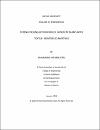Strengthening of reinforced concrete beams With Textile- Reinforced mortars
| Advisor | Ebead, Usama |
| Author | Afzal, Muhammad Shekaib |
| Available date | 2018-02-12T09:55:59Z |
| Publication Date | 2016 |
| Identifier | ORCID ID: http://orcid.org/0000-0002-3713-4964 |
| Abstract | This study involves an experimental work for using textile reinforced mortar (TRM) to increase the flexural strength of reinforced concrete (RC) beams. Two different types of textiles namely carbon and Polyparaphenylene benzobisoxazole (PBO) were used as strengthening materials. The studied parameters included the type of mortar, type of strengthening material, number of TRM layers, and reinforcement ratio. Eighteen 18 beams were tested under four-point loading until failure. The beams were reinforced with 2D10, 2D12 and 2D16 as main steel reinforcement. Three beams were tested as control specimens namely R1, R2 and R3 respectively. Nine beams were externally reinforced with one layer〖(EA)〗_c^1=12.56 kN/mm, two layers 〖(EA)〗_c^2=25.12 kN/mm and three layers 〖(EA)〗_c^3= 37.68 kN/mm of the carbon TRM system. The other six beams were strengthened using one 〖(EA)〗_PBO^1=6.4 kN/mm and two layers 〖(EA)〗_PBO^2=12.8 kN/mm of the PBO TRM system. The experimental work concluded that a reasonable gain in the flexural strength was achieved for both the strengthening systems, with an average increase of 38% when carbon TRM system was used and an average of 26.7% for the PBO TRM system compared to their respective control specimen. The highest increase in the load carrying capacity was 77.51% for a specimen having the main reinforcement of D12 and was strengthened with carbon TRM system using three layers of carbon textile 〖(EA)〗_c^3= 37.68 kN/mm. The lowest increase in the ultimate load capacity was 6.60% for a specimen having the main reinforcement of D16 and was strengthened with one layer of the PBO 〖(EA)〗_PBO^1= 6.4 kN/mm strengthening system. Further, PBO system showed comparatively stronger interfacial bond behavior within the TRM system and further between the TRM layer and concrete substrate, which resulted in higher ductility index and higher energy absorption. Moreover, during the experimentation, it was seen that the technique of applying the TRM system also considers the contractor’s ease where the construction workers (although not very skilled) can easily implement the technique after being given simple demonstrations. |
| Language | en |
| Subject | Flexural Strengthening Interfacial Bond Behavior Reinforced Concrete Beams Stiffness Textile Reinforced Mortar Civil engineering Engineering |
| Type | Master Thesis |
| Department | Civil Engineering |
Files in this item
This item appears in the following Collection(s)
-
Civil Engineering [48 items ]


